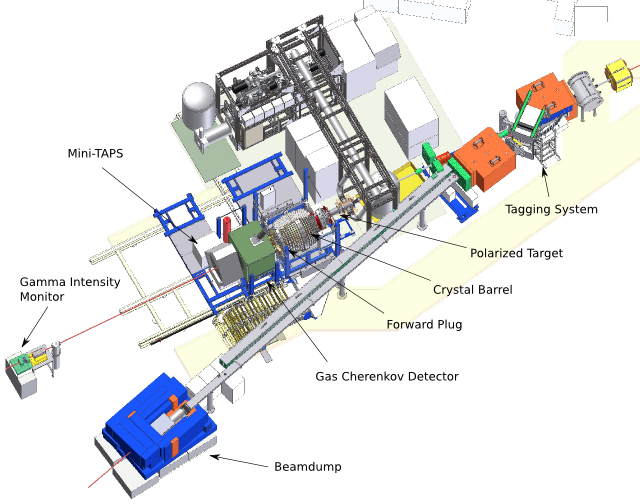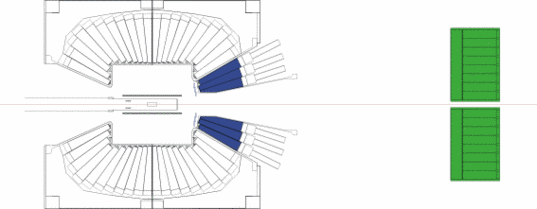Crystal-Barrel@ELSA experiments
For results of the CB-ELSA experiment, please, refer to the publications section.
More information on future projects and upgrades can be found here.
CB-ELSA/TAPS (TR 16) (measuring 2005-...)

CB-ELSA TR16 experimental setup.
The new beam times are currently being planned. The major changes for the new beam times include:
- Availability of linearly and circularly polarised photons after moving to the new experimental area
- The three rings of crystals in forward direction are combined in a new detector with fast triggering capabilities and charged particle vetos in front of the crystals.
- Mini-TAPS and MOMO for the very forward angles
- Polarised targed (butanol)
- New tagging system

Forward detector plug and Mini-TAPS
CBELSA/TAPS (measuring 2001-2003)

For CBELSA/TAPS, the forward three rings of the Crystal Barrel were removed and TAPS was positioned in forward direction.
- Availability of polarised beam photons using bremsstrahlung off a diamond crystal
- New tagging system with better resolution and high rate stability: Scintillating fibres were implemented to replace upper MPWC (higher rates, better resolution).
- Fast forward triggering capability and better resolution using TAPS, greater coverage of solid angle than with the Crystal Barrel alone
- Triggering: TAPS, inner detector, FACE
- Targets: LH2, LD2, C, Ca, Nb, Pb
For results of the CBELSA/TAPS experiment, please, refer to the publications section.
CB-ELSA (measuring 2000-2001)

The characteristics of the experiment were:
- Incident electron beam energies of up to 3.2 GeV
- Photons produced by bremsstrahlung of amorphous copper radiator
- Energy determination of scattered electrons in dipole spectrometer. The tagging system consisted of a large magnet and the tagging hodoscope (14 scintillators for timing, 352 wires in two proportional chambers for spatial resolution).
- Tagged photon energies between 25 and 95% of the incident electron energy
- Liquid hydrogen target
- Inner scintillating fibre detector for charged particle identification consisting of 513 fibres arranged in three layers with different orientations with respect to the beam: parallel, +25°, -25° (helix).
- Time-of-flight walls in forward direction (θ < 12°)
- Photon detector for flux determination (lead mineral oil Cherenkov)
- Triggering: Hit in tagging system, multiplicity in final state >2 (3), proton in inner detector or TOF
The CB-ELSA experiment used the Crystal Barrel in its original arrangement.
